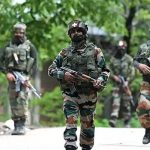China’s military posture toward Taiwan has evolved into one of the most significant elements of its broader strategic calculus in the Indo-Pacific. The People’s Liberation Army (PLA) has increasingly taken center stage in this policy, functioning not only as a tool of deterrence but also as a mechanism to prepare for and potentially execute military ‘reunification with Taiwan’. The recent expansion in the scale, frequency, and complexity of PLA military activities around Taiwan reveals a clear shift in emphasis, from symbolic coercion to tangible operational readiness.
The PLA has rapidly modernized its capabilities over the last decade, and its force posture has become more dynamic and forward-leaning in the Taiwan Strait. In February 2025, the PLA Eastern Theatre Command conducted a large-scale series of live-fire drills around Taiwan, deploying multi-service formations and integrated strike elements in a manner that simulated joint-force operations across air, sea, and cyber domains. Similarly, China had also conducted large scale exercises, shortly after the inauguration of Taiwan’s new administration under President Lai Ching-te in May 2024. China’s actions reflected China’s strategic intent to apply calibrated military pressure while demonstrating credible force projection.
Amphibious landing simulations were conducted in conjunction with coordinated naval-air patrols, missile launches, and blockade scenarios, with the PLA Navy deploying amphibious assault vessels such as Type 075 landing helicopter docks and Type 071 transport ships. The PLA Air Force conducted sorties involving advanced fighter platforms, while support assets, including airborne early warning systems and surveillance drones, operated across the eastern and southwestern theatre zones. Simulated fire missions were conducted targeting notional command nodes and coastal infrastructure, with the strategic messaging clearly aimed at Taiwan’s leadership and foreign observers.
These exercises are not isolated shows of force but components of a coherent strategic trajectory in which military readiness is seamlessly fused with political signalling. The PLA’s activities are designed to create a persistent pressure environment, gradually altering the military status quo in China’s favour. Regular incursions into Taiwan’s Air Defense Identification Zone (ADIZ) have become routine, integrating fighter aircraft, bomber formations, electronic warfare platforms, and drones in complex maneuvers that aim to test Taiwan’s response thresholds and collect intelligence on its air defence systems. The operational tempo of these incursions has increased steadily over the past two years. While these actions fall below the threshold of open conflict, they serve the dual purpose of psychological attrition and strategic habituation. They also provide the PLA with vital real-time experience in cross-domain coordination, particularly in contested airspace, enhancing its capacity for seamless escalation if required.
PLA’s actions in the last two years suggests that it is no longer simply engaged in deterrence operations, but is building the doctrinal, logistical, and operational frameworks required for a high-intensity military campaign across the strait. Recent exercises have demonstrated key components of an integrated island-seizure campaign, including anti-ship missile deployment, electronic jamming against coastal radar installations, drone swarms, cyber defence drills, and precision strike simulations against strategic infrastructure.
The Rocket Force has expanded its deployment of intermediate-range and short-range ballistic missiles, many of which are capable of targeting fixed installations, ports, and command-and-control centres in Taiwan. The integration of hypersonic glide vehicles further enhances China’s capacity to conduct rapid decapitation strikes against high-value targets while complicating intercept and response mechanisms from Taiwan and its security partners.
Parallel to kinetic preparedness, the PLA is actively engaged in grey-zone warfare. Drone incursions over Taiwan’s offshore islands, low-altitude reconnaissance flights near garrisons in Kinmen and Matsu, and coordinated psychological warfare campaigns are all indicative of a broader information domain strategy. Cyber intrusions into civilian and military networks have intensified, particularly during periods of political transition in Taiwan, with embedded information operations targeting the morale and cohesion of Taiwanese society.
The PLA’s expanding role in China’s Taiwan policy also reflects an internal political shift under Xi Jinping’s leadership. The military is no longer just an executor of defence directives; it is a central actor in shaping the political messaging and deterrent architecture of the Taiwan Strait. Xi’s repeated declarations of national reunification as a historic imperative underscore the alignment of political objectives with military capabilities. The current trajectory of the PLA’s posture suggests that China intends to maintain the military option as a credible, rehearsed, and rapidly executable contingency.
The consolidation of PLA command structures under the Central Military Commission and the continued restructuring of theatre commands have further enhanced the capacity for rapid joint operations. The Eastern Theatre Command, specifically designated for Taiwan operations, has been prioritized in exercises and procurement. The standardization of combat drills simulating full-scale amphibious operations, denial-of-access strategies, and integrated logistics support is indicative of a long-term planning architecture that moves well beyond passive deterrence.
This evolving dynamic has triggered substantial recalibration among regional and extra-regional actors. The United States continues to provide defensive systems and training support to Taiwan, integrating it into broader Indo-Pacific contingency planning. Japan has elevated Taiwan’s security to a national interest, expanding its military capabilities in southern island chains. The Philippines has increased cooperation with the United States under the Enhanced Defense Cooperation Agreement, providing basing access in locations proximate to the Bashi Channel. Australia, South Korea, and ASEAN states have also expressed growing concern over the potential for unintended escalation.
However, the deterrence calculus remains precarious. While enhanced external support for Taiwan may delay or complicate Beijing’s timeline for action, it also increases the risk of strategic misperception. As the PLA’s operational readiness continues to improve, its political influence within China’s strategic decision-making architecture also grows, raising the likelihood of military adventurism under the pretext of internal legitimacy or perceived external provocation.
The strategic ambiguity that once governed cross-strait relations is being eroded by the increasing normalization of PLA operations. China’s military policy vis-à-vis Taiwan is no longer reactive or purely deterrent; it is proactive, integrated, and escalatory in structure, designed to dominate the conflict spectrum from grey-zone operations to full-spectrum warfighting.
The implications for regional stability are profound. PLA’s transformation reflects a deliberate reorientation of China’s Taiwan strategy, one that prepares for conflict as much as it seeks to prevent it. The distinction between deterrence and war-preparedness is narrowing, and the military dimension is now central, not auxiliary, to Beijing’s Taiwan policy.
Unless there is a shift in political calculus from Beijing or a new equilibrium is achieved through regional deterrence frameworks, the PLA’s growing role will continue to shape the trajectory of cross-strait relations in increasingly militarised terms. The strategic question is no longer whether China can apply military pressure on Taiwan, but whether it is willing to convert that pressure into decisive action and whether the region is prepared for that possibility.
Biblography
Al Jazeera. (2023, April 4). Philippines gives US access to more military bases. https://www.aljazeera.com/news/2023/4/4/philippines-gives-us-access-to-more-military-bases
Center for Strategic and International Studies. (2024). China Power Project. https://chinapower.csis.org
Center for Strategic and International Studies Missile Defense Project. (2024). People’s Republic of China missile forces. https://missilethreat.csis.org/country/china/
CNA. (2023). China’s amphibious capabilities and exercises. https://www.cna.org/reports/2023/china-amphibious
Department of Defense. (2023). Military and security developments involving the People’s Republic of China 2023. https://media.defense.gov/2023/Nov/29/2003348811/-1/-1/1/2023-MILITARY-AND-SECURITY-DEVELOPMENTS-INVOLVING-THE-PEOPLES-REPUBLIC-OF-CHINA.PDF
FireEye. (2022). Chinese cyber espionage campaigns. https://www.fireeye.com/current-threats.html
Grossman, D., & Ma, Y. (2023). China’s grey zone tactics in the Taiwan Strait. RAND Corporation. https://www.rand.org/pubs/commentary/2023/03/chinas-grey-zone-tactics-in-the-taiwan-strait.html
International Institute for Strategic Studies. (2023). The military balance 2023. Routledge.
Japan Ministry of Defense. (2023). Defense of Japan white paper 2023. https://www.mod.go.jp/en/publ/w_paper/2023.html
Kastner, S. L. (2022). China’s coercion toward Taiwan: Deterrence, escalation, and the role of U.S. policy. Brookings Institution. https://www.brookings.edu/articles/chinas-coercion-toward-taiwan/
Ministry of National Defense, Taiwan. (2024). Daily air incursion reports. https://www.mnd.gov.tw
RAND Corporation. (2023). PLA military exercises and Taiwan contingency scenarios. https://www.rand.org
Reuters. (2024, May 24). China launches military drills around Taiwan after new president takes office. https://www.reuters.com/world/asia-pacific/china-launches-military-drills-around-taiwan-after-new-president-2024-05-24/
Swaine, M. D. (2022). Beijing’s strategic objectives in the Taiwan Strait. Carnegie Endowment for International Peace. https://carnegieendowment.org/2022/08/11/beijing-s-strategic-objectives-in-taiwan-strait-pub-87759
Talmadge, C. (2021). Deterrence and escalation in cross-strait relations. International Security, 46(2), 7–50. https://doi.org/10.1162/isec_a_00418
Tanner, M. (2024). Military pressure and political signaling: Understanding the PLA’s Taiwan strategy. Center for Strategic and International Studies. https://www.csis.org/analysis/military-pressure-and-political-signaling-understanding-plas-taiwan-strategy
White House. (2024, February 10). Fact sheet: U.S. Indo-Pacific strategy. https://www.whitehouse.gov/briefing-room/statements-releases/2024/02/10/fact-sheet-indo-pacific-strategy/
Xinhua. (2021, October 9). Xi Jinping: China must and will be reunified. http://www.xinhuanet.com/english/2021-10/09/c_1310238876.htm













